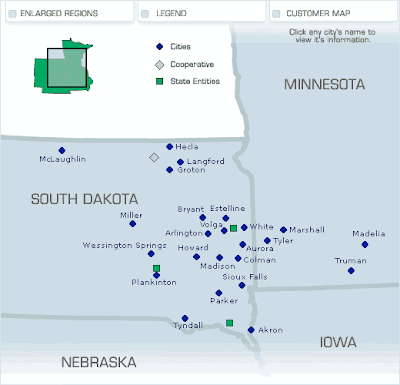South Dakota landscape being sold off to foreign energy firms
 Brown and Babcock, the Australian firm that has purchased Northwestern Energy has announced plans to build a 3,000-acre 34-turbine wind farm near Wessington Springs. The announcement was made by former PUC Commisioner Jim Burg, mayor of Wessington Springs, and Mike McDowell, CEO of Heartland Consumers Power District, which has contracted to purchase t
Brown and Babcock, the Australian firm that has purchased Northwestern Energy has announced plans to build a 3,000-acre 34-turbine wind farm near Wessington Springs. The announcement was made by former PUC Commisioner Jim Burg, mayor of Wessington Springs, and Mike McDowell, CEO of Heartland Consumers Power District, which has contracted to purchase t he power output. Heartland is headquartered in Madison, S.D., and serves parts of South Dakota, Minnesota, Iowa and Nebraska. (See the blue areas on the map to the left.)
he power output. Heartland is headquartered in Madison, S.D., and serves parts of South Dakota, Minnesota, Iowa and Nebraska. (See the blue areas on the map to the left.)
Babcock and Brown, which has 27 offices throughout the world, lists its business activities as:
*Real Estate
*Infrastructure and Project Finance
*Operating Leasing
*Structured Finance
*Corporate Finance
Babcock and Brown operates windfarms in Australia and its subsidiaries are whole owners and part owners of wind farms throughout the U.S. with such partners as GE and BP.
At week's end, the North Dakota Public Service Commission approved the construction of a 10-mile transmission line which will connect 120 wind turbines in McPherson County, South Dakota, and Dickey County, North Dakota, to the North Dakota electrical grid. The project is being done by Tatanka Wind Power LLC. Tatanka is a wholly-owned subsidiary of Acciona Wind Energy USA which is a wholly-owned subsidiary of Acciona SA, which is headquartered in Madrid, Spain.
Are you beginning to get the picture who is taking over the ownership and will reap the profits fr0m the sale of energy in our region?
Two years ago, Deere & Co. announced the creation of a financing program for individual farmers to construct one or two wind turbines on their land and "harvest" the wind along with other crops. This would have helped stabilize farm profits and softened the effects of the up-and-down price cycles of livestock and grain. The Tacoma Park Association, which owns a belt of prime wind land on the eastern bluffs of the James River, looked into the possibility of erecting some wind turbines and joining with other landowners to create a windfarm. However, inquiries and plans got bogged down by the questions of who to sell the power to and the the construction of transmission lines to get the power to the buyers.
Wind farms in northern South Dakota and southern North Dakota have had a fitful history. Large corporations do not want to deal with individual producers united into a production cooperative, and have backed out of deals for leasing land from individual land owners. So, the corporations buy or lease the land and assume total ownership and control over the energy production and distribution.
The takeover of American utilities and energy companies (BP, for example, is a British-based company and Shell is Dutch) is happening at a very rapid rate.
Globalists say this is the new age we live in. A few people worry about what happens as Americans lose control of their own infrastructure and are squeezed out of participation in it by huge foreign corporations.
Those who control the infrastructure control the country. And so it goes. Australian and Spanish wind turbines in the South Dakota sunset.

1 comment:
Your post indicates a major problem with windpower developement so far in South Dakota.
It makes SD a windfarm colony of out of state or international firms. The profits will fly away. We will be left with the whirrrrrr.
Using wind energy to generate electricity directly for movement to power grids is the basic mistake. The wind energy should be used to generate hydrogen which can be converted to methane by pulling carbon dioxide out of the atmosphere.
This generates a fuel that works in existing fuel delivery systems and can also be a base for chemicals.
South Dakota should use tax-assisted capital accumulation to build a wind energy industry so the profits remain here.
Post a Comment